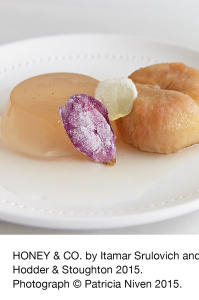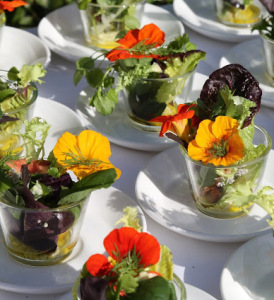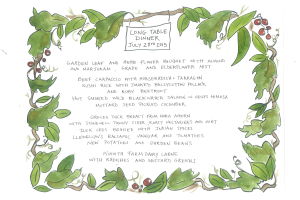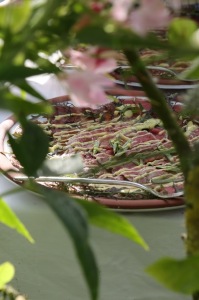
You all know that I’m fans of Honey & Co., a teeny weeny but soon to be bigger restaurant in London. Sarit and Itamar have been over to us twice and we love their simple homesy Middle Eastern food.
Not sure how they do it but they’ve just come out with a new cookbook, their second in less than 12 months.
Their first, Honey & Co won the Sunday Times and the Fortnum & Mason cook book of the year awards.
This one is on Baking “our day is marked by what comes out of the pastry section, and there’s always something good on the way: sticky cherry and pistachio buns in the morning: loaf of rich dough rolled with chocolate, hazelnuts and cinnamon that comes out of the oven fresh for elevenses. Lunch is a crisp, crumbly shell of pastry filled with spiced lamb or burnt aubergine, and at teatime there are cookies, cheesecakes, fruit cakes – so many cakes that it’s hard to choose one. After dinner there might be poached peaches with roses or something more traditional – sweet and salty Knafe drenched in orange blossom syrup. There’s something sweet, something in the oven for everyone, all day long – welcome to Honey & Coâ€.
So it’s not all cakes and sticky buns, there are good things for breakfast, elevenses, lunch, teatime and dinner and even some pretty irresistible suggestions for after dark.
At present the restaurant in Fitzrovia has just 10 tables it’s what you might call cosy, some of their customers come in several times a day. The downstairs kitchen is also tint, how five chefs and three pastry chefs, three kitchen porters and seven waiters and Louisa in the office, co-exist and run up and down the stairs is an astonishing feat in itself.
They are all united by a love for food, a zest for life “even though its only part of what we do the pastry section is the backbone of the operation the driving force and the powerhouse . What baking requires represents everything we want our staff to have and our customers to feel – consideration, concentration, experience, patience, of course, but also a lot of passion, greed, an eagerness to please on an industrial scale and a great big heart. Our days are governed now by the rhythm of the pastry: weighing, mixing, kneading, shaping, baking, chilling, glazing, serving.
Of course it’s not just sweet, there’s an excellent chapter at the beginning of the book on ingredients and particularly the quality of the ingredients for baking, the butter, the cream, the sugar and flour, the vanilla, the chocolate, the nuts, the gelatine. They quite rightly emphasize the  quality you choose has a major impact on the end result, a fact oft forgotten in our quest for the cheapest ingredients nowadays.
If we’re going to spend time in the kitchen, the end result might as well be as delicious as possible and of course on the quality of the ingredients and the recipe. There’s lots to tempt us in Honey & Co Baking Book by Sarit and Itamar published by Saltyard Book Company
Hot Tips
It’s Blueberry Time –
Irish blueberries are in season and in abundance this year so for goodness sake, check the label and don’t bring home blueberries that have travelled thousands of miles from Chile or Peru. My seven year old granddaughter Amelia made the most delicious blueberry pancakes for breakfast this morning from blueberries that she and her brother and sister had just picked in the blueberry patch. – They are made in minutes – here’s the recipe:
Amelia’s Blueberry Pancakes
Makes 12
110g (4ozs/1 cup) self-raising flour
1 teaspoon baking powder
25g (1oz/1/8 cup) caster sugar
pinch of salt
1 egg
110ml (4fl ozs/1/2 cup) milk
50 g (2 oz) blueberries
drop of sunflower oil, for greasing
Sift the flour and baking powder into a bowl, add the sugar and salt and stir to mix. Make a well in the centre, crack in the egg and whisk, gradually drawing in the flour from the edge. Add the milk gradually, whisking all the time, to form a smooth batter. Fold in the blueberries gently.
Lightly grease a frying pan and warm it over a moderate heat. Drop 3 tablespoons (3 American tablespoons + 3 teaspoons) of the batter into the pan, keeping well apart so they don’t stick together. Cook for about 2 minutes or until bubbles appear on the surface and begin to burst and the drop scones are golden underneath, then flip them over and cook on the other side for a minute or until golden on this side as well.
Remove from the pan and serve warm with butter and a sprinkling of caster sugar. (If you wish, wrap the drop scones in a clean tea towel to keep warm while you make the rest.)
Taste of West Cork Festival events are now up on the web – what a line up. You’ll need to be pretty snappy to get a table for Andy McFadden of L’ Autre Pied and Luke Matthews dinner at the Mews in Baltimore on Friday 11th September . Tel: 028 20572
But they’re just two of the star attractions. There are lots of other options Derry Clare, Carmel Somers, JP McMahon…..check out www.atasteofwestcork.com
Date for your diary: Slow Food Galway will visit Galway Goat Farm on Sunday August 23rd at 12 noon. There is a tour of the farm and cheese and yoghurt making followed by a delicious lunch. For more information contact Kate O’ Malley kateomalleycat@yahoo.com or 087 931 2333
Burekas
This recipe makes twice the amount you need for a single batch of burekas, but it is a versatile dough that freezes well, so it is worth making the full amount and keeping some for another day. If you prefer, you can halve the quantities; the only problem
you face is halving an egg. The best way is to crack it into a little dish, whisk well and then use half. Use the remaining beaten egg to glaze the pastry before baking.
Waste not, want not. Made throughout the Balkans, burekas are savoury pastry parcels with different fillings, often potato, cheese or meat. The pastry varies as well, from short and crumbly to layered and crunchy, like filo or puff, or even doughy, more like bread
rolls. For home baking I have found none better than this, the pastry dough that will change your baking life – our famed ‘dough number 4’. It is easy to make, failsafe and extremely tasty. At Honey & Co we use this for a few of our breakfast
bakes, and it is great for canapés and pies. Alternatively, you could buy ready-made puff pastry and just make the fillings. It is cheating but the burekas will still be delicious, and no one need know. You can prepare your burekas in advance and
freeze them; just remember they need to be thawed before baking so that the filling is nice and hot by the time the pastry is cooked. The fillings here are a few tried-and tested suggestions. If you experiment with different fillings, be sure to over-season
slightly, to make up for the fact that they will be wrapped in pastry.
Â
Makes about 1kg
500g plain flour
½ tsp caster sugar
1½ tsp table salt
1 tsp baking powder
250g cold unsalted butter, diced
125g full fat cream cheese
1 egg
125g/ml double cream
Place all the ingredients in a mixer bowl with a paddle attachment or in a food processor and work them together to form a nice smooth dough. (You could of course do this by hand, in which case you will need to rub the butter into the flour and other dry ingredients before mixing in the cream cheese, egg and double cream.) The idea is to keep everything cold and not to overwork the dough – you want some flecks of butter running through, as this will result in a lovely flaky texture once baked. Form the dough into a ball, press down to flatten it, wrap in cling film and chill in the fridge for at least 1 hour. You can prepare the dough up to 3 days in advance of baking – just keep it wrapped in cling film in the fridge until you need it.
If you are making a full batch but only need half for now, divide it in two, wrap both pieces in cling film, then put one in the fridge and the other in the freezer. It keeps well for up to a month; simply thaw before rolling and filling.
Â
Lamb lahma with pine nuts & cherry tomatoes
2 tbsp olive oil
2 onions, peeled and diced
500g lamb mince
2 tbsp baharat spice mix
2 tbsp tomato purée
60g tahini paste
50g/ml water
a pinch of table salt
10 cherry tomatoes, quartered
50g pine nuts
Heat the olive oil in a large frying pan on a high heat, then add the diced onions. Sauté until they are soft and starting to colour (this will take about 8–10 minutes), then add the minced meat. Keep the heat high and mix the meat around vigorously to break it into little pieces. Season with salt and pepper, stir in the spice mix and continue cooking until the meat has browned (this should take about 5–6 minutes). Stir in the tomato purée and cook for another 2–3 minutes. Taste and adjust the seasoning as necessary, then remove to a bowl to cool a little. Mix the tahini paste with the water and the salt, whisking it until it becomes smooth. Place a spoonful of tahini in the centre of each dough disc and spread it around a little. Cover with the cooked lamb, then top with the cherry tomatoes and pine nuts. Carefully lift each lahma onto the preheated tray and bake for 8–10 minutes. We like to serve this with extra tahini dip and a fresh tomato salad.
12/8/2015 (CS) (18509) Home & Co The Baking Book
Poached Peaches with Rose Jelly & Crystallised Rose Petals
We make this dessert in summer when peaches and roses are in high season. Since finding a constant supply of good unsprayed roses can be tricky, all our staff are under clear instructions to loot whatever gardens they have access to, so everyone comes to their shift bearing gifts of roses for Giorgia.
Â
For the poached peaches
200g caster sugar
200g/ml water
some strips of peel and the juice of 1 lemon
some strips of peel and the juice of 1 orange
1 cinnamon stick
1 tsp rose water
4 flat white peaches
50g/ml vodka
For the jelly
160g/ml peach cooking liquid
3 gelatine leaves (or the appropriate quantity for about 330g/ml liquid, according to the manufacturer’s instructions)
160g/ml cold water
1–2 tsp rose water
For the crystallised rose petals (if you like)
1 egg white
caster sugar
fresh garden roses
To elevate this dessert to something heavenly
a good splash of sparkling wine for each plate
To poach the peaches, place all the ingredients apart from the peaches and vodka in a saucepan and bring to the boil. Score the skin at the base of each peach with a little cross to just pierce the skin but not cut through the flesh. Once the liquid is boiling, place the peaches in it and cook for 1 minute. Take the pan off the heat and use a slotted spoon to remove the peaches to a bowl. Once they are cool enough to touch, peel off the skin; it should come away easily. Return the peeled peaches to the cooking liquid in the pan and bring to the boil again. Once it has come to the boil, turn the heat off (if the peaches you are using are very hard, you may want to cook them for 2–3 minutes before turning off the heat). Add the vodka, then leave the peaches and their poaching liquid in the pan to cool. While the peaches are cooling, strain 160g/ml of the poaching liquid into a small bowl (leave the peaches in the remainder). Soak the gelatine in cold water (follow the manufacturer’s instructions), then remove, squeeze out the excess water and add the gelatine to the hot poaching liquid to melt. Once it has melted, stir in the cold water and rose water. Pour into four individual moulds and place in the fridge to chill until the jelly sets. This will take at least 2 hours and anything up to 5 hours, depending on the gelatine used. If you are crystallising the rose petals, start by mixing the egg white with a pinch of sugar in a small bowl. Tip some caster sugar into a shallow saucer or dish. Dip a petal in the egg white mixture, then in the sugar, coating both sides. Lay the petals on a wire rack or a tray lined with baking parchment and leave to crisp and dry –this will take at least 6 hours, and up to 8 if the room is very cold. You can then keep
Makes 4 portions of the lightest, prettiest dessert them in an airtight container for up to 2 weeks, but make sure not to refrigerate as they will soften. When you come to serve, the best way to get the jelly out of the moulds is to find a bowl that the jelly mould can fit into easily and to fill it with boiling water. Dip the mould in the hot water for 2 seconds and remove, then use your finger to pull the jelly a little to the side. This will allow air to come between the jelly and the mould; if you then flip the mould onto a serving plate, the jelly will slide out. Repeat with the other jellies. Place a peach at the side of each jelly and pour over a little of the cooking liquor. Then just splash with some sparkling wine and garnish with the rose petals, if using.
12/8/2015 (CS) (18506) Honey & Co The Baking Book
Courgette, Golden Raisin & Pistachio Cake
At the end of our street is the head office of Caprice Holdings Ltd, the group that operates some of the best and glitziest restaurants in London. Alvin and Kate work there, and treat us as their canteen. We know Alvin’s weird coffee order, and that Kate will have hot chocolate in winter and sparkling lemonade in the warmer months. They are both great lovers of cake, and whenever there is a birthday in the office we get an order for one with some silly writing on it – ‘Cheers, all the best’ or ‘Shiiiiiiiit’ – often private jokes that only they understand. This cake is their absolute favourite (they have a horrible nickname for it – ‘the green goddess’ or ‘green velvet’), so this recipe is for them, in the hope that they will never bake it themselves, but instead keep on coming to us for it.
Makes 1kg (2lb) loaf
60g pistachios
175g self-raising flour
a pinch of table salt
1 tsp ground ginger
½ tsp ground star anise
200g light brown soft sugar
50g caster sugar
175g/185ml olive oil
2 eggs
60g golden raisins
3 courgettes, unpeeled but trimmed,
grated (200g)
zest of 1 lemon
Preheat the oven to 190°C/170°C fan/gas mark 5. Butter a 1kg (2lb) loaf tin and line the base and long sides with a sheet of baking parchment, allowing a little overhang at the sides. Once the oven is hot, roast the pistachios for 8 minutes. Keep them whole and leave to cool a little. Mix the flour, salt, ginger and star anise together and add the pistachios. Place the sugars and oil in a large mixing bowl (or you could use a machine with a whisk attachment if you are super-lazy) and whisk together until combined. Whisk the eggs in one at a time and keep whisking until you have a lovely emulsified texture, a little like mayonnaise. Now add the rest of the ingredients, get rid of the whisk and use a large spoon or spatula to fold and combine to an even mixture. Transfer the cake batter to your lined loaf tin and bake for 35 minutes. Turn the tin around so that it bakes evenly and leave for a further 15–20 minutes. The end result should have a lovely springy feel. Allow to cool in the tin before removing. This will keep in an airtight container for up to 3 days and for up to a week if you store it in the fridge.
12/8/2015 (CS) (18507) Honey & Co The Baking Book



